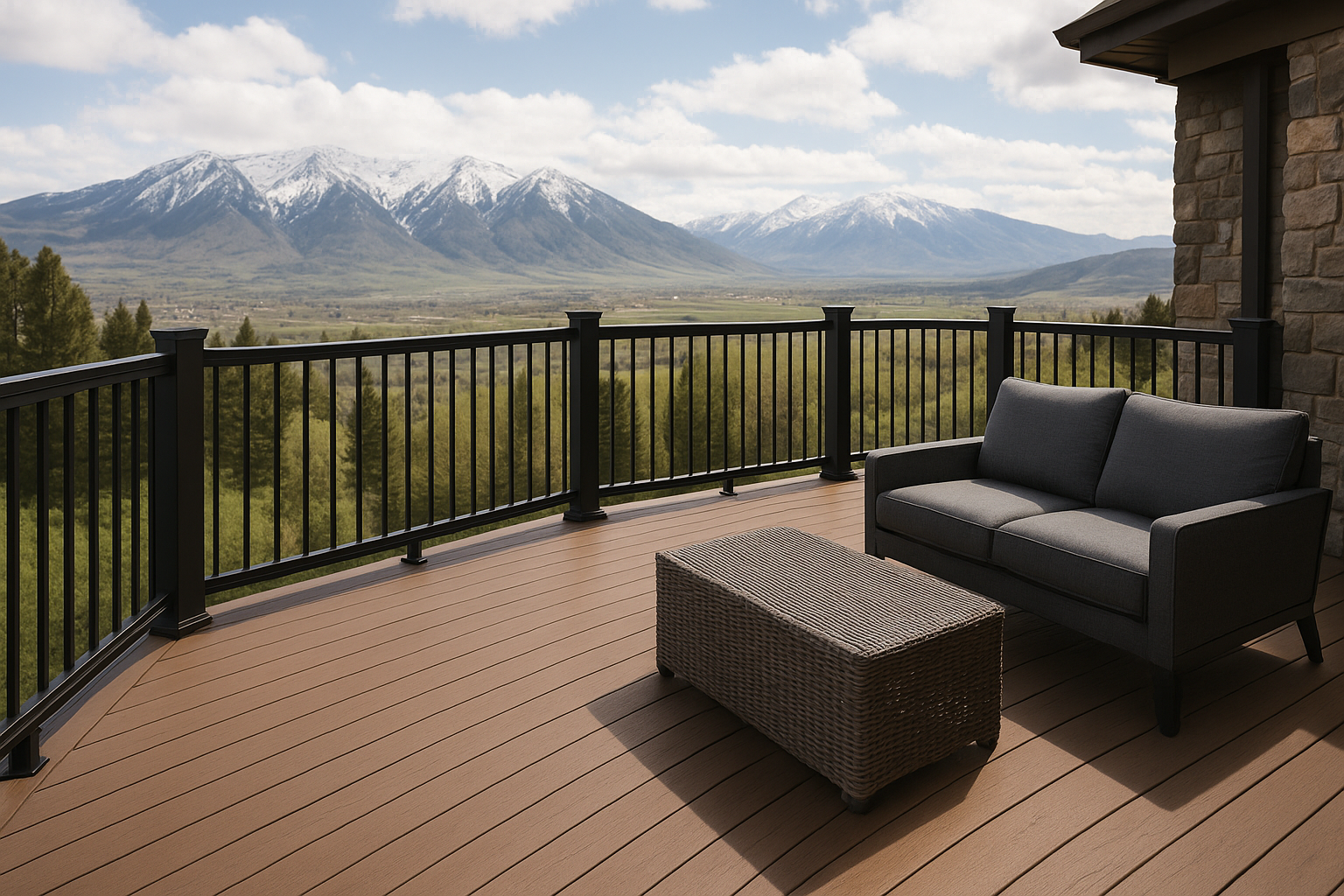If you’ve been staring at your deck thinking, “It needs a Railing that looks sharp and won’t eat my weekends,” you’re not alone. Cinch Railing has been winning fans across Salt Lake, Davis, and Utah Counties because it does two things very well: it looks clean and it installs fast. Homeowners like the straightforward kits; contractors like the time savings and dependable quality. And you know what? Both groups like that it stands up to Wasatch Front weather without demanding much in return.
What makes Cinch Railing a “cinch”?
Here’s the thing: railing can feel complicated—angles, code, little parts. Cinch Railing simplifies the whole process. It’s a modular Aluminum system with smart brackets, clean profiles, and reliable finishes. Most projects follow a rhythm: set posts, attach panels, cap the rail. It’s predictable, which is half the battle on a deck build.
Why homeowners and pros keep reaching for it:
- Durable aluminum that won’t warp, rot, or rust like Steel or wood.
- Powder-coated finish that resists fading and scratches.
- Panels and brackets engineered to fit—less fiddling, fewer “do-overs.”
- A modern, slim look that pairs with composite decking or stained Lumber.
- Low maintenance—soap, water, done.
It’s not showy, but it is sharp. The design fades into the background and lets your deck, mountain view, and evening light do the talking.
Built for Utah’s sun, snow, and big temperature swings
Along the Wasatch Front, we get triple-digit sun in July and sideways snow in January. Then freeze-thaw cycles like clockwork. Aluminum shines here. It doesn’t swell, split, or twist when the temperature jumps 40 degrees between afternoon sun and a cool canyon breeze later that night.
A few local perks:
- UV-stable powder coat holds color at altitude—less chalking and fading.
- Corrosion resistance that stands up to winter ice melt and spring storms.
- Sturdy posts and top rails that feel solid when a gust sweeps off Parley’s or Provo Canyon.
Honestly, it’s hard to beat the low-drama upkeep. No yearly staining. No sanding. Just rinse and get back to the grill.
DIY-friendly, contractor-fast: install notes that actually help
Let me explain how most installs go, whether you’re in Bountiful or Saratoga Springs. Layout matters more than anything. Once the post centers are true, the rest feels easy.
Basic flow we see on jobsites:
- Block and secure posts to framing (Simpson DTT2Z or equivalent tension ties are your friend).
- Plumb, tighten, then re-check. It’s boring; it also saves you an hour later.
- Measure, cut panels with a non‑ferrous blade (a miter saw with a fine-tooth carbide blade works).
- Attach brackets, set the panel, snap on the covers. It’s satisfying.
- Cap the rail, add footblocks where required, touch up cut ends as recommended.
Tools that make life easier: a torpedo level, impact driver, 3/16″ drill bit, T25/T30 bits, painter’s tape for clean cuts, and a speed square. Stair runs? Use the adjustable brackets and sneak up on your angle—test fit, then tighten. Contractors tell us the system cuts install time compared to piece-by-piece builds, which adds up across a big wraparound deck in Draper or a second-story balcony in Layton.
Looks that play nice with your deck (and your view)
Cinch Railing leans modern without getting too edgy. Slim balusters keep sightlines open, and the top rail feels balanced—comfortable to lean on, not bulky. Most homeowners gravitate toward textured black or bronze, though white can look great on craftsman porches in Sugar House or Lehi.
Infill choices vary by project, but here’s the short version:
- Classic baluster panels for a timeless, low‑maintenance look.
- Horizontal cable on certain layouts when you want a more open view (check local codes and HOA rules).
- Stair panels that match the level runs—clean, continuous lines.
Pairing it with decking is easy. It complements composite brands like Trex and Timbertech, and it pops against natural Cedar or redwood. Want a little glow? Ask us about compatible post caps and low‑voltage lighting; subtle lighting changes the whole mood on summer nights.
Code compliance without the headaches
Nobody wakes up excited to read the IRC, but a safe, compliant rail is non‑negotiable. The good news: Cinch Railing is engineered with code in mind, and we’ll help you match your county’s requirements.
Quick checklist for most residential decks around Salt Lake, Davis, and Utah Counties (verify with your inspector):
- Guard height: 36″ minimum on decks 30″ or more above grade.
- Openings: less than a 4″ sphere anywhere a child could reach through.
- Stairs: handrail height 34″–38″, continuous graspable profile.
- Strength: guards must resist a 200‑lb point load.
- Stair triangle: less than 6″ at the tread/risers/rail junction.
We can walk your layout, spot trouble areas, and match components that keep your inspector happy. A small tweak early beats a big change late.
Cost, value, and the long game
Is Aluminum Railing cheaper than wood on day one? Sometimes not. But it usually wins by year three. Wood needs stain and replacement parts; steel needs paint and constant watch for rust. Aluminum just keeps doing its job. Many Cinch Railing setups include a strong Structural warranty and a finish warranty—ask us for the exact coverage on the series you choose.
If you’re a contractor bidding a time-sensitive project in Murray or Orem, the predictable install time is a real edge. Fewer callbacks. Fewer weather delays. Cleaner punch lists. That all shows up as value, whether you’re the one building or the one writing the check.
Questions we hear all the time
- Can I cut panels to fit odd spans? Yes—measure twice, use a non‑ferrous blade, and we’ll supply touch‑up guidance.
- What about stairs that aren’t a perfect angle? Adjustable brackets handle common slopes; bring a photo or measurements and we’ll help.
- Does it work with composite sleeves or existing posts? Often yes, with the right brackets and blocking. We’ll confirm on site photos or plans.
- Will it chip in winter? The powder coat is tough; normal wear happens, but it holds up very well with basic care.
- How do I clean it? Mild soap, soft brush, rinse. Skip harsh abrasives.
If you’re juggling a tricky corner or a gate, bring a sketch. A five‑minute chat can save a Saturday.
Timing, stock, and local support
Spring rush gets busy along the Wasatch Front—contractors line up jobs from March through July. If you’re planning a new deck in Sandy or a replacement rail in Farmington, give yourself a little runway. Utah Deck Supply keeps popular Cinch Railing colors and sizes in stock, and we can special‑order what we don’t have on the shelf.
We serve Salt Lake County, Davis County, and Utah County every day. Pickup is quick, and delivery options are available. Need posts and brackets this week and stair panels next week? We’ll stage it so your crew keeps moving.
Ready to price your rail and see samples?
Let’s make your deck safer, better looking, and easier to live with. Call Utah Deck Supply at 385-993-5492, and we’ll walk you through Cinch Railing options, finishes, and lead times. Prefer to type instead of talk? Go ahead and Request a Free Quote. Bring your measurements—or just a rough sketch—and we’ll help you turn it into a clean, code‑ready plan that feels right on your home.




